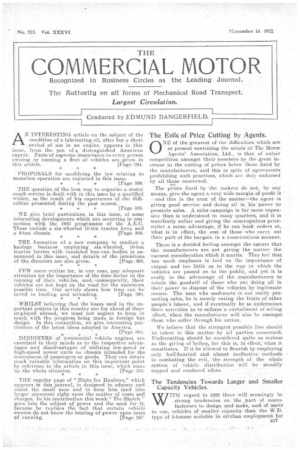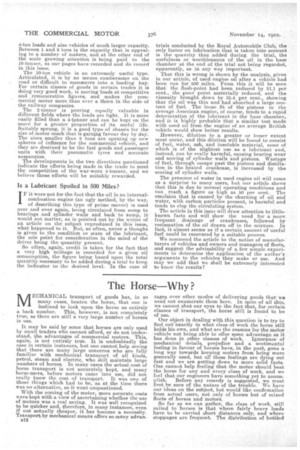The Evils of Price Cutting by Agents.
Page 1

Page 2

If you've noticed an error in this article please click here to report it so we can fix it.
0 NE of the greatest of the difficulties which are at present exercising the minds. of The Motor Agents' Association, Ltd., is that of unfair competition amongst. their members by the great increase in the cutting of prices below Nose fixed by the manufacturers, and this in spite of agreements prohibiting such practices, which arc drily endorsed by all those concerned.
The prices fixed by the makers do not, by any means, give -the agent a very wide margin of profit it -7 and this is the crux of the matter—the agent is giving good service and doing all in his power to promote sales. A sales campaign is far more expensive than is understood in many quarters, and it is manifestly unfair and giving the unscrupulous pricecutter a mean advantage, if he can book orders at, what is in effect, the cost of those who carry out their part of the bargain in a conscientious manner.
There is a decided feeling amongst the agents that the manufacturers are not. giving the matter the 'earnest consideration which it merits. They feel that too touch emphasis is laid on the importance of output and too little as to the way in which the vehicles are passed on to the public, and yet it is really to the advantage of the manufacturers to ' retain the goodwill of those who are doing all in their power to dispose of the vehicles by legitimate means. The man who undercuts" is not really promoting sales, he is merely eating the fruits of other people's labour, and if eventually he so undermines their activities as to enforce a curtailment of selling effort, when the manufacturer will also he amongst those who suffer through his action.
We believe that the strongest possible line should be taken in this matter . by all parties concerned. Undercutting should be. considered quite as serious as the giving of 'brilleF.i,„ for this is, in effect," what it constitutes. If it be allowed to flourish by employing only half-hearted and almost . ineffective, methods in combating the evil, " the strength of the whole system of vehicle distribution will be ' steadily sapped and rendered effete.
The Tendencies Towards Larger and Smaller Capacity Vehicles.
WITH regard to 1923 there will seemingly be strong tendencies on the part of manufacturers to design and make, and, of users to use, vehicles of smaller, capacity than the W.D.
type of 3-tonner suitable in civilian employment for 4-ton loads and also vehicles of much larger capacity. Between 1 and 2 tons is the capacity that is appealing to a. number of makers, and at the other end of the scale growing attention is being paid to the 10-tonner, as our pages have recorded and do record in this issue.
The 10-ton vehicle is an extremely useful type. Articulated, it is by no means cumbersome on the road or difficult to rnanceuvre into a loading bay. For certain classes of goods in certain trades it is doing very good work, is moving loads at competitive and remunerative figures, and makes the commercial motor more than ever a thorn in the side of the railway companies.
The 2-tonner is proving equally valuable in different fields where the loads are light. It is more easily filled than a 4-aenner and can be kept on the move for a greater proportion of its useful life. Suitably sprung, it is a good type of chassis for the size of motor coach that is gaining favour day by day. The sizes smaller than 2 tons are opening up new spheres of influence for the commercial vehicle, and they are destined to be the fast goods and passenger units with their pneumatic tyres and accurate suspension.
The developments in the two directions mentioned indicate the efforts being made in the trade to meet the competition of the war-worn 4-tonner, and we believe those efforts will be suitably rewarded.
Is a Lubricant Spoiled in MO Miles?
IF it were not for the fact that the oil in an internalcombustion engine (an ugly method, by the way, of describing this type of prime mover) is used over and over again, being circulated from sump to bearings and cylinder walls and back to sump, it would not matter, as is pointed out by the writer of an article on the subject reproduced in this issue, what happened to it. But, so often, never a thought is given to the condition or state of the lubricant, the sole point for consideration in the mind of the driver being the quantity present.
So often, again, credit is taken for the fact that a very high mileage is recorded for a given oil consumption, the figure being based upon the total quantity necessary to be added during a trial to keep the indicator to the desired level. In the case of trials conducted by the Royal Automobile Club, the only factor on lubrication that is taken into account is the quantity thus added during the trial, the usefulness or worthlessness of the oil in the base chamber at the end of the trial not being regarded, apparently, as in any way important.
That this is wrong is shown by the analysis, given in our article, of used engine oil after a vehicle had been run for 500 miles. From this it will be seen that the flash-point had been reduced by 51.1 per cent., the pour point materially reduced, and the viscosity brought down by 35.4 per cent., showing that the oil was thin and had absorbed a large content of fuel. The loose fit of the pistons in the average American engine, of course, tends to a rapid deterioration of the lubricant in the base chamber, and it is highly probable that a similar test made with used oil from the engine of an average British vehicle would show better results.
However, dilution to a greater or lesser extent must occur, and this dilution will be found to consist of fuel, water, ash, and insoluble material, none of which is of the slightest use as a lubricant and, instead, can be really harmful, causing bearing wear and scoring of cylinder walls and pistons. Wastage of fuel, through escape past the pistons and distillation in the heated crankcase, is increased by the scoring of cylinder walls.
The presence of water in used engine oil will come as a surprise to many users, but our article shows that this is due to normal operating conditions and can reach a figure as high as 50 per cent. The emulsion that is caused by the churning of oil and water, with carbon particles present, is harmful and tends to clog the circulating system.
The article in this issue will draw attention to littleknown facts and will show the need for a more frequent drainage of crankcases., followed by reclamation of the oil drawn off in the mixture. In fact, it, almost seems as if a certain amount of useful fuel could be recovered by a suitable process.
We commend the article to the notice of manufacturers of vehicles and owners and managers of fleets, and suggest the advisability of a few simple experiments to determine the application of the author's arguments to the vehicles they make or use. And may we add that we shall be extremely interested to know the results?
































